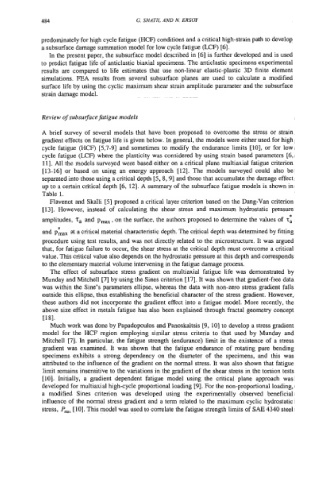Page 500 - Biaxial Multiaxial Fatigue and Fracture
P. 500
484 G. SHATIL AND N. ERSOY
predominately for high cycle fatigue (HCF) conditions and a critical high-strain path to develop
a subsurface damage summation model for low cycle fatigue (LCF) [6].
In the present paper, the subsurface model described in [6] is further developed and is used
to predict fatigue life of anticlastic biaxial specimens. The anticlastic specimens experimental
results are compared to life estimates that use non-linear elastic-plastic 3D finite element
simulations. EA results from several subsurface planes are used to calculate a modified
surface life by using the cyclic maximum shear strain amplitude parameter and the subsurface
strain damage model.
Review of subsurfkce fatigue models
A brief survey of several models that have been proposed to overcome the stress or strain
gradient effects on fatigue life is given below. In general, the models were either used for high
cycle fatigue (HCF) [5,7-91 and sometimes to modify the endurance limits [lo], or for low
cycle fatigue (LCF) where the plasticity was considered by using strain based parameters [6,
111. All the models surveyed were based either on a critical plane multiaxial fatigue criterion
[13-161 or based on using an energy approach [12]. The models surveyed could also be
separated into those using a critical depth [S, 8,9] and those that accumulate the damage effect
up to a certain critical depth [6, 121. A summary of the subsurface fatigue models is shown in
Table 1.
Flavenot and Skalli [S] proposed a critical layer criterion based on the Dang-Van criterion
[ 131. However, instead of calculating the shear stress and maximum hydrostatic pressure
amplitudes, 2, and pmax, on the surface, the authors proposed to determine the values of 2:
and pLax at a critical material characteristic depth. The critical depth was determined by fitting
procedure using test results, and was not directly related to the microstructure. It was argued
that, for fatigue failure to occur, the shear stress at the critical depth must overcome a critical
value. This critical value also depends on the hydrostatic pressure at this depth and corresponds
to the elementary material volume intervening in the fatigue damage process.
The effect of subsurface stress gradient on multiaxial fatigue life was demonstrated by
Munday and Mitchell [7] by using the Sines criterion [17]. It was shown that gradient-free data
was within the Sine’s parameters ellipse, whereas the data with non-zero stress gradient falls
outside this ellipse, thus establishing the beneficial character of the stress gradient. However,
these authors did not incorporate the gradient effect into a fatigue model. More recently, the
above size effect in metals fatigue has also been explained through fractal geometry concept
U81.
Much work was done by Papadopoulos and Panoskaltsis [9, 101 to develop a stress gradient
model for the HCF region employing similar stress criteria to that used by Munday and
Mitchell [7]. In particular, the fatigue strength (endurance) limit in the existence of a stress
gradient was examined. It was shown that the fatigue endurance of rotating pure bending
specimens exhibits a strong dependency on the diameter of the specimens, and this was
attributed to the influence of the gradient on the normal stress. It was also shown that fatigue
limit remains insensitive to the variations in the gradient of the shear stress in the torsion tests
[lo]. Initially, a gradient dependent fatigue model using the critical plane approach was
developed for multiaxial high-cycle proportional loading [9]. For the non-proportional loading,
a modified Sines criterion was developed using the experimentally observed beneficial
influence of the normal stress gradient and a term related to the maximum cyclic hydrostatic
stress, Pmx [lo]. This model was used to correlate the fatigue strength limits of SAE 4340 steel

